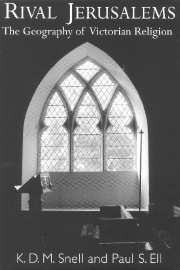Book contents
- Frontmatter
- Contents
- List of figures
- List of tables
- Preface and acknowledgements
- Introduction
- Part 1 Religious geographies: the districts of England and Wales
- Part 2 Religion and locality: parish-level explorations
- Technical appendices
- A Denominational statistics
- B The correction of census data
- C The religious measures
- D Computer cartographic methods
- E Landownership and the Imperial Gazetteer
- F An 1861 Census of Religious Worship?
- Bibliography
- Index
C - The religious measures
Published online by Cambridge University Press: 08 August 2009
- Frontmatter
- Contents
- List of figures
- List of tables
- Preface and acknowledgements
- Introduction
- Part 1 Religious geographies: the districts of England and Wales
- Part 2 Religion and locality: parish-level explorations
- Technical appendices
- A Denominational statistics
- B The correction of census data
- C The religious measures
- D Computer cartographic methods
- E Landownership and the Imperial Gazetteer
- F An 1861 Census of Religious Worship?
- Bibliography
- Index
Summary
In this appendix, we outline the different measures used in this book. If in doubt, the reader should use this section as a reference point for the chapters and maps, and for subsequent research. It should contribute a better understanding of the various measures that are made possible by the Census of Religious Worship, and that can be applied or adapted to some other religious sources.
The ‘index of attendances’. This is defined as total attendances (morning+afternoon+evening), expressed as a percentage of registration-district (or in part 2 of the book, parish) population. This is the measure we have used most commonly. It is well established in the historiography. We used the index of attendances partly because it allows our findings to be compared most readily with earlier arguments by other authors. It is one of the most direct measures available, and (unlike a sittings measure) has the main advantage of allowing one to discern the actual strength of worship on Census Sunday. As discussed in chapter 1, for the registration-district data the index of attendances (like other registration-district attendance measures) includes Sunday scholars, as Horace Mann added Sunday school attendances to general-congregation attendances in his published registration-district tables. For the parish data we kept Sunday scholars separate to allow greater precision in data handling.
Care must be taken in the interpretation of the index of attendances.
- Type
- Chapter
- Information
- Rival JerusalemsThe Geography of Victorian Religion, pp. 431 - 437Publisher: Cambridge University PressPrint publication year: 2000



